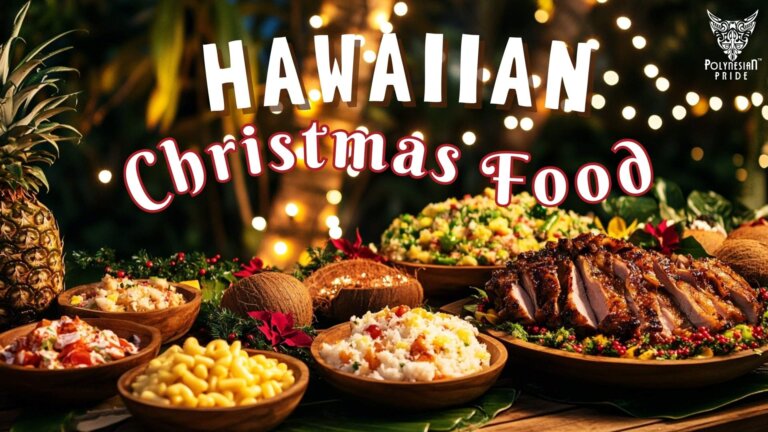Explore Fiji Traditional Food: Culinary Delights & Culture

Fiji traditional food is a captivating culinary treasure trove, reflecting the rich cultural heritage and vibrant diversity of this island nation. Beyond its famed crystal-clear waters and idyllic beaches, Fiji offers a unique adventure for your taste buds. Get ready to explore the flavors of traditional food in Fiji as we delve into the key ingredients, popular dishes, and the cultural significance behind each delectable bite.
Popular Traditional Fijian Dishes
Fiji’s traditional dishes celebrate its diverse cultural influences, with each dish reflecting a unique blend of flavors and ingredients. These dishes are not only delicious but also represent the history and heritage of Fijian culture.
Kokoda

Kokoda is one of the most popular and well-known traditional Fijian dishes. Similar to ceviche, it features raw fish marinated in coconut milk, lime juice, onions, and chilies. Typically served with cassava chips or fried plantains, Kokoda is a refreshing and flavorful dish perfect for a hot day.
Lovo

A lovo is a traditional Fijian method of cooking food in an earth oven. Food is wrapped in banana leaves and cooked over hot stones. This method is often used to prepare large feasts for special occasions and celebrations. Popular ingredients cooked in a lovo include marinated meats, root vegetables, and seafood.
Rourou

Rourou, also known as “palusami”, is made from taro leaves cooked in coconut milk. The leaves are first blanched and then filled with a mixture of coconut cream, onions, and sometimes corned beef. The parcel is wrapped in banana leaves and cooked in an earth oven or on the stovetop. Rourou is a delicious and comforting dish often served alongside other traditional Fijian food.
Palusami
Palusami is similar to rourou but uses young taro leaves. The leaves are stuffed with a mixture of coconut cream and either corned beef, fish, or chicken, then boiled or steamed. Palusami is popular at local markets, restaurants, and village gatherings.
Duruka

Duruka, also known as “Fijian asparagus”, is a seasonal delicacy. This wild fern grows on trees and is available only for a few months each year. Usually boiled, sautéed, or added to soups and stews, duruka has a delicate, slightly nutty flavor.
Fish Suruwa

Fish Suruwa is a traditional Fijian curry made with fresh fish, coconut milk, and spices. The fish is cooked until tender in a rich and creamy curry sauce, making it a flavorful and satisfying dish.
Ivi Yaca or Tavioka

This is a Fijian dish made of cassava, which can be boiled, baked, or grated. It is then cooked in coconut cream with sugar and bananas and served as dessert.
Cawaki

Sea urchin, locally known as Cawaki, is the only edible species in Fiji. So much so that it has become a popular delicacy in coastal villages. Cawaki is found in Fiji’s shallow coral reef ecosystem. The women of Fiji provide the primary collection process for the Cawaki, after which they take the Cawaki to sell at markets. In turn, near Suva, collecting and selling sea urchins is now a women’s income source.
Grilled Mahi Mahi

The fish most often used when making Kokoda is Mahi Mahi, a fish from the deep waters around Fiji. It is very popular and is usually grilled or cooked in a frying pan and served with vegetables.
Fijian Roti and Curry

Fijian roti and curry are staple meals in many Fijian households. The roti, a type of flatbread, is often made fresh and served with various curries, including chicken, lamb, fish, and vegetable curries. The curries are typically rich and flavorful, made with spices, coconut milk, and fresh ingredients.
Fijian Lamb Stew (Vakalavalava)
Vakalavalava is a traditional Fijian lamb stew that is hearty and comforting. The lamb is slow-cooked with root vegetables like taro, cassava, yams, coconut milk, garlic, and ginger. This stew is often enjoyed during family gatherings and special occasions.
Baigan Valo
Baigan Valo is a popular Fijian eggplant dish. The eggplants are sliced, stuffed with a spicy mixture of garlic, chilies, and spices, and then baked or fried. This dish is often served as a side dish or appetizer.
Nama Salad

Nama, also known as sea grapes, is a seaweed commonly found in Fijian waters. Nama salad is a refreshing dish with sea grapes, onions, tomatoes, and lemon juice. It’s often enjoyed as a light appetizer or side dish.
Kumala (Sweet Potato)

Kumala, or sweet potato, is a versatile ingredient in Fijian cuisine. It can be roasted, boiled, or mashed and is often used in both savory and sweet dishes. One popular preparation is kumala pie, made with sweet potatoes, coconut milk, and spices.
Fijian Cassava Pudding
Cassava pudding is a traditional Fijian dessert made from grated cassava, coconut milk, and sugar. The mixture is baked until it forms a firm yet creamy texture, making it a deliciously sweet and satisfying end to a meal.
Kokoda and lovo are two of the most popular and well-loved traditional dishes in Fiji, often served together at special occasions and celebrations. Across the country, you can find a variety of other traditional dishes, all showcasing the unique flavors and ingredients of Fiji traditional food.
Traditional Beverages
In addition to delicious food, Fiji offers a range of traditional beverages that are an essential part of Fijian culture. These beverages are often enjoyed during celebrations, ceremonies, or simply as a refreshing drink on a hot day.
Kava

Kava is a traditional Fijian drink with significant cultural importance. Made from the kava root, which is ground and mixed with water, it creates a murky, earthy-tasting beverage. Kava is believed to have relaxing and soothing properties and is often consumed during ceremonies and social gatherings.
Coconut Water

Coconut water is another popular drink in Fiji and is widely available throughout the country. The clear liquid inside a young coconut is known for its hydrating and refreshing properties. Coconut water is often served chilled, making it a perfect way to quench your thirst on a hot day.
Staple Ingredients in Fijian Cuisine
Fiji’s traditional food is a captivating tapestry woven from simple yet powerful ingredients. For centuries, these staples have formed the foundation of delicious and nourishing meals, reflecting the bounty of Fiji’s fertile lands and abundant seas. Indigenous Fijians, who have inhabited the islands for over 3,500 years, laid the groundwork for this cuisine. Throughout history, interaction with Polynesian, Melanesian, and Indian cultures further enriched Fijian culture food, resulting in a unique and diverse culinary landscape. Let’s explore these core ingredients that continue to define traditional Fiji foods:
Root Vegetables
Taro, cassava, and yams are the cornerstone ingredients in Fijian cuisine, forming the base of many traditional dishes for centuries. Not only a source of sustenance, these starchy root vegetables hold a significant place in Fijian cultural identity. They are typically prepared by boiling, baking, or roasting, showcasing their versatility in both savory and sweet dishes. Let’s delve into these essential ingredients:
- Taro: This root vegetable with a purple exterior and creamy white flesh boasts a mild, slightly nutty flavor, perfect for curries, stews, and puddings. Rich in complex carbohydrates and fiber, taro contributes significantly to a well-balanced Fijian diet. It’s also used to make the traditional Fijian dish “rourou”, made from taro leaves cooked in coconut milk.

- Cassava: Also known as “manioca” in Fiji, this tuber has light brown skin and a white interior. It is often compared to a potato in texture and flavor. A good source of vitamin C, cassava is a mainstay in Fijian cuisine. It’s commonly used in soups, stews, casseroles, and its leaves are also edible and used in some dishes.

- Yams: Over 200 varieties are grown in Fiji. They have rough, bark-like skin and creamy flesh. They are typically used in stews, roasted or mashed, and are also popular in desserts like “kulolo”, a sweet pudding made from grated yam and coconut milk. Packed with nutrients, yams offer a healthy and satisfying addition to any Fijian meal.
Seafood
Seafood is a significant part of Fijian cuisine, as the Pacific Ocean surrounds the country. Fish, crabs, and shellfish are commonly caught and used in traditional Fijian food, providing a source of protein and essential nutrients.

- Fish: A staple in the Fijian diet, fish is often served raw in dishes like “kokoda”. It is also grilled in coconut leaves (wrapped in banana leaves), steamed, or fried. Popular types of fish in Fiji include tuna, mahi-mahi, and snapper.
- Crabs: A delicacy often used in dishes like “lolo” (crab cooked in coconut milk) and “palusami” (young taro leaves filled with coconut cream and crab meat). Mud crabs and blue swimming crabs are commonly caught and eaten in Fiji.
- Shellfish: Abundant in Fiji, shellfish are used in dishes such as “lovo”, where they are cooked in an earth oven with other ingredients. Popular types include clams, mussels, and prawns.
Fruits and Vegetables

Fiji’s tropical climate allows for the growth of a variety of fruits and vegetables, which are incorporated into traditional Fijian dishes to add both flavor and nutrition. These include coconuts, breadfruit, bananas, and various types of tropical greens.
- Coconut: A versatile ingredient in Fijian cuisine, used in many forms, including grated, milk, and oil. It adds richness and creaminess to dishes and is also used in desserts like “kasava lolo” (cassava cooked in coconut milk and sugar). Besides its versatility, coconut is a good source of healthy fats and dietary fiber.
- Breadfruit: A large fruit with green skin and white flesh, similar in texture to a potato. It is often boiled, baked, or fried and used in stews and curries. It can also be roasted and eaten as a snack or used in desserts like “breadfruit cake”.

- Bananas: Widely grown in Fiji and used in both savory and sweet dishes. They are often made into “banana chips”, a popular snack in Fiji, and are also added to curries and stews for a touch of sweetness.
- Tropical Greens: Taro leaves, pumpkin leaves, and water spinach are commonly used in Fijian cuisine. These nutrient-rich greens are usually cooked in coconut milk and served alongside other dishes as a vegetable side dish.
Spices and Condiments
Fijian cuisine incorporates a variety of spices and condiments to add depth and flavor to dishes, creating a unique culinary experience. Traditional Fijian condiments like chilies, curry leaves, and coconut milk, used in various forms such as fresh, dried, powdered, or as a paste, play a crucial role in building the taste profile of Fijian food.
- Chilies: Add a fiery kick to Fijian dishes. Bird’s eye chilies are popular for their heat, while Fijian long chilies offer a more flavorful profile. They are used whole, chopped, or blended into a paste and are also a key ingredient in the traditional Fijian hot sauce called “lolo”, made with chilies, lemon juice, and coconut milk.

- Curry Leaves: A staple in Indian-inspired Fijian dishes, curry leaves add a fragrant and slightly bitter flavor. Typically dried, they are infused into dishes during cooking to release their aroma.
- Coconut Milk: A foundational ingredient in Fijian cuisine, coconut milk provides a creamy texture and rich, sweet flavor. Made by grating coconut meat and squeezing out the liquid, it adds versatility to Fijian cooking, forming the base for curries, stews, and even sweet desserts.
Fijian Food Festivals and Events
Fiji’s vibrant culinary scene comes alive throughout the year with a variety of food festivals and events. These celebrations offer a delightful opportunity to savor traditional dishes, witness unique cooking methods, and experience the warmth of Fijian culture.
Hibiscus Festival
Held annually in Suva, the Hibiscus Festival is a vibrant showcase of Fijian culture, with food playing a starring role. Stalls overflow with an array of Fijian favorites like kokoda, lovo, and palusami, tempting visitors with their enticing aromas. Cooking demonstrations and competitions add another layer of excitement, allowing visitors to witness traditional recipes come to life and gain insights into Fijian culinary techniques.

Bula Festival
Nadi comes alive with the lively Bula Festival, another fantastic venue to explore Fijian cuisine. A dedicated “food village” tantalizes the senses with an array of Fijian specialties, from fresh seafood dishes to exotic fruits and local spices. Visitors can embark on a culinary adventure, sampling unique ingredients and indulging in the colorful presentations of Fijian cuisine. Live entertainment and other cultural activities create a festive atmosphere, making the Bula Festival a must-visit for a truly immersive Fijian food experience.
Lovo Nights
Many resorts and local communities host Lovo Nights, offering visitors a chance to partake in a traditional Fijian feast. Imagine the warm glow of a firelight illuminating an evening filled with laughter and the enticing aroma of food slow-cooked in an underground earth oven (lovo). Lovo Nights provide a unique opportunity to savor an authentic Fijian meal cooked using this age-old method, often accompanied by lively entertainment and cultural performances, creating a memorable experience that goes beyond just the food.
Where to Try Traditional Fijian Food
To truly experience the flavors of Fiji, it’s best to try traditional food in its most authentic setting. Here are some recommendations for where you can find and enjoy traditional Fijian cuisine.
Local Markets
Visiting local markets is a must when in Fiji, not only for the vibrant atmosphere but also for the opportunity to sample traditional foods. The Suva Market and Nadi Market are two of the largest and busiest markets in Fiji, offering a wide variety of fresh produce, meats, and seafood. You can also find food stalls selling traditional dishes like kokoda, lovo, and palusami. These markets are perfect places to immerse yourself in the local culture and taste authentic Fijian food.
Village Visits
For a more immersive experience, consider visiting a Fijian village and experiencing traditional food in a local setting. Many villages offer guided tours, during which visitors can learn about Fijian culture, witness traditional cooking methods, and enjoy a meal with the locals. This is a unique opportunity to taste traditional Fijian cuisine and understand the cultural significance behind each dish.
Resorts and Restaurants
If you prefer a more comfortable dining experience, some resorts and restaurants in Fiji specialize in traditional Fijian cuisine. These establishments often offer a range of dishes, from appetizers to desserts, showcasing the diverse flavors and ingredients of Fiji. Whether you’re dining at a luxury resort or a local eatery, you can savor the rich tastes of Fijian food in a relaxed and enjoyable setting.
Health Benefits of Fijian Traditional Foods
Fijian traditional foods are not only delicious but also offer various health benefits due to their use of natural and organic ingredients. Here are some ways in which Fijian cuisine can nourish your body.
Nutrient-Rich Ingredients
Many staple ingredients in Fijian cuisine, such as taro, coconut, and seafood, are rich in essential nutrients. Taro is an excellent source of fiber, vitamins, and minerals, promoting digestive health and overall well-being. Coconut is high in healthy fats and antioxidants, supporting heart health and boosting the immune system. Seafood, especially fish, is an excellent source of protein, omega-3 fatty acids, and other essential nutrients, contributing to brain health and reducing inflammation.
Natural and Organic
Traditional Fijian food relies heavily on fresh, locally sourced ingredients, making it often natural and organic. This means it is free from harmful chemicals and additives, offering a healthier option for your body. Consuming organic food can reduce your exposure to pesticides and synthetic fertilizers, promoting better health and reducing the risk of chronic diseases.
Cooking Fijian Food at Home
If you’re inspired to try your hand at cooking traditional Fijian dishes at home, here are some simple recipes and tips to get you started. Embracing the flavors of Fijian traditional food in your kitchen can be a rewarding and delicious experience.
Fiji Traditional Food Recipes
Kokoda Ingredients:
- 1 lb white fish (such as mahi-mahi or snapper), cubed
- 1 cup coconut cream
- Juice of 2 limes
- 1 small onion, finely chopped
- 1 small red chili, finely chopped
- Salt and pepper to taste
Instructions:
- In a bowl, combine the fish, lime juice, onion, chili, salt, and pepper. Mix well and let it marinate in the refrigerator for at least 30 minutes.
- Add the coconut cream to the marinated fish mixture and stir gently to combine.
- Serve chilled as an appetizer or light meal.
Lovo Ingredients:
- 1 whole chicken, cleaned
- 1 lb pork belly, cubed
- 1 lb lamb, cubed
- 4 large taro roots, peeled and sliced
- Banana leaves
- Salt and pepper to taste
Instructions:
- Season the chicken, pork, and lamb with salt and pepper.
- Wrap each type of meat separately in banana leaves.
- Dig a hole in the ground and start a fire to create hot coals.
- Place the wrapped meats in the hole, cover them with more banana leaves, and bury them with soil.
- Let the meats cook in the earth oven for 2-3 hours.
- Uncover and serve with steamed taro.
Tips for Cooking Fijian Food
- Use fresh ingredients: Traditional Fijian dishes rely on fresh and locally sourced ingredients for the best flavor.
- Experiment with spices: Fijian cuisine uses a variety of spices and herbs to enhance the taste of dishes. Feel free to experiment with different combinations.
- Cook with love: Traditional Fijian cooking is often done with care and attention to detail. Take your time and enjoy the process of preparing a delicious meal.
Conclusion
Traditional Fijian food is a vibrant reflection of Fiji’s rich cultural heritage. From the earthy flavors of kokoda to the smoky goodness of lovo, Fijian cuisine offers a diverse array of dishes that showcase unique ingredients and cooking techniques. Exploring these Fijian dishes not only delights your taste buds but also deepens your appreciation for the history and culture of this beautiful island nation.
Ready to embark on your Fijian food adventure? Start planning your trip to Fiji or discover Fijian recipes online and bring the taste of the islands to your kitchen!
FAQs
What is the most popular food in Fiji?
Kokoda is widely considered one of the most popular and iconic traditional foods in Fiji. This dish of raw fish marinated in coconut milk, lime juice, onions, and chilies is a favorite among locals and visitors alike.
What is the national dish of Fiji?
Kokoda, Fiji’s national dish, is a ceviche made using just-caught, local fish marinated in lime juice and served with a zingy salad. The key to making good kokoda is the miti—a coconut milk mix that balances the acidity of the lime with the sweetness of the coconut.
What do they eat for breakfast in Fiji?
Breakfast may include a lolo bun (a freshly baked bun soaked with coconut milk), pancakes, babka and parole, boiled eggs and fruit of the day, or scones and pudding. Draunimoli tea (lemon tea) is always served at breakfast and throughout the day.
What is kava Fiji food?
Kava, otherwise known as yaqona or, quite simply, grog, is the traditional national drink of Fiji. It is a mildly narcotic and sedative drink made from the crushed root of the yaqona (pronounced yang-GO-na) strained with water. It is served in a large communal bowl as part of the traditional kava ceremony.

I am Leilani Miller – I research focusing on Vanuatu – volcanic landscapes, blue holes, coral reefs & rainforests. I have over five years of experience researching and sharing insights on tourism and environmental activism. Explore and experience without limits through my latest article.
Contact information:
Email: [email protected]
Tel: +1 (808) 555-1528






